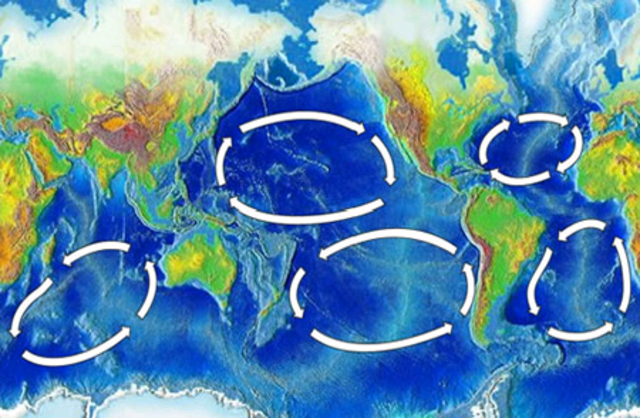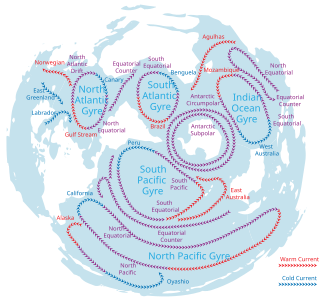Ocean gyre
large system of rotating ocean currents From Wikipedia, the free encyclopedia
Remove ads
A gyre is a large system of ocean currents moving in a circle. Gyres are caused by the Coriolis effect. Because the Earth is rotating, ocean currents in the northern hemisphere tend to move in a clockwise direction and currents in the southern hemisphere move in an anti-clockwise direction.[1]

The Coriolis force acts most strongly on the wind, and the atmospheric circulation then creates a torque that tends to spin the surface ocean currents.[2]
The Earth rotates from the west towards the east, and the Coriolis effect becomes more intense toward the poles. Because of this, gyres form strong currents on the western side of oceans, so they are pushed against the eastern coast of continents.[1][2] The vorticity (the strength of the torque force) is balanced out by frictional surface currents, which normally act against the spin of the water. However, in the middle of the ocean, the effects of friction are very weak.[2][3]
The term gyre can be used to mean any type of vortex in the air or the sea, but it is most used in oceanography for the major ocean current systems.
Remove ads
Major gyres
These are the five largest gyres:[4]
- Indian Ocean Gyre
- North Atlantic Gyre
- North Pacific Gyre
- South Atlantic Gyre
- South Pacific Gyre
Other gyres

Tropical gyres
Tropical gyres tend to be mostly east-west with minor north-south extent.
- Atlantic Equatorial Current System
- Pacific Equatorial Current System
- Indian Monsoon Gyres
Subtropical gyres
The centre of a subtropical gyre is a high pressure area, which the ocean moves around. The high pressure in the centre is due to the westerly winds on the northern side of the gyre and easterly winds on the southern side of the gyre. These cause frictional surface currents towards the latitude at the centre of the gyre.
Subpolar gyres
Subpolar gyres form at high latitudes (around 60°). The ocean moves around a low pressure area. Surface currents generally move outward from the centre of the system.
Remove ads
Related pages
Wikimedia Commons has media related to Oceanic gyres.
References
Other websites
Wikiwand - on
Seamless Wikipedia browsing. On steroids.
Remove ads
